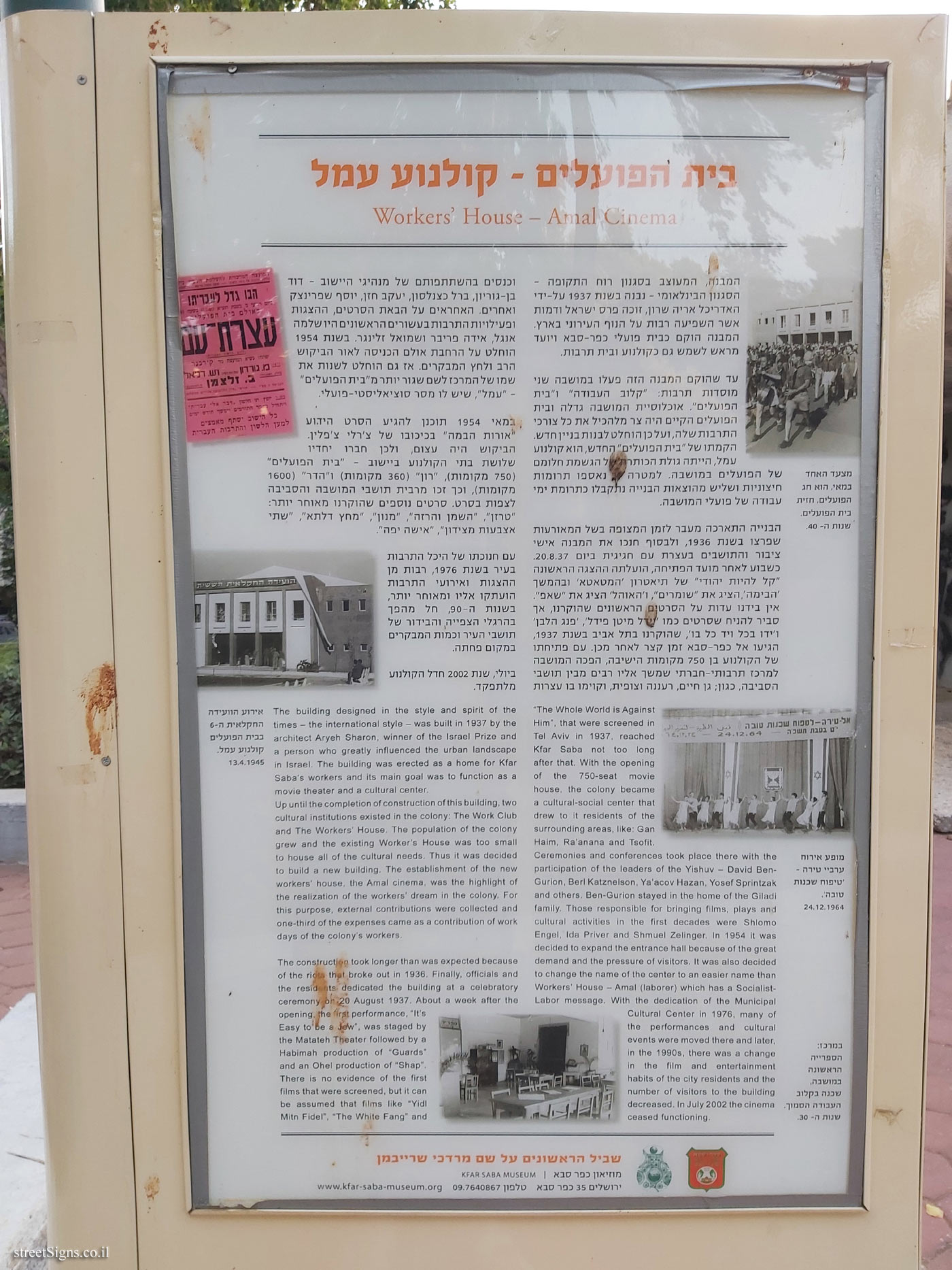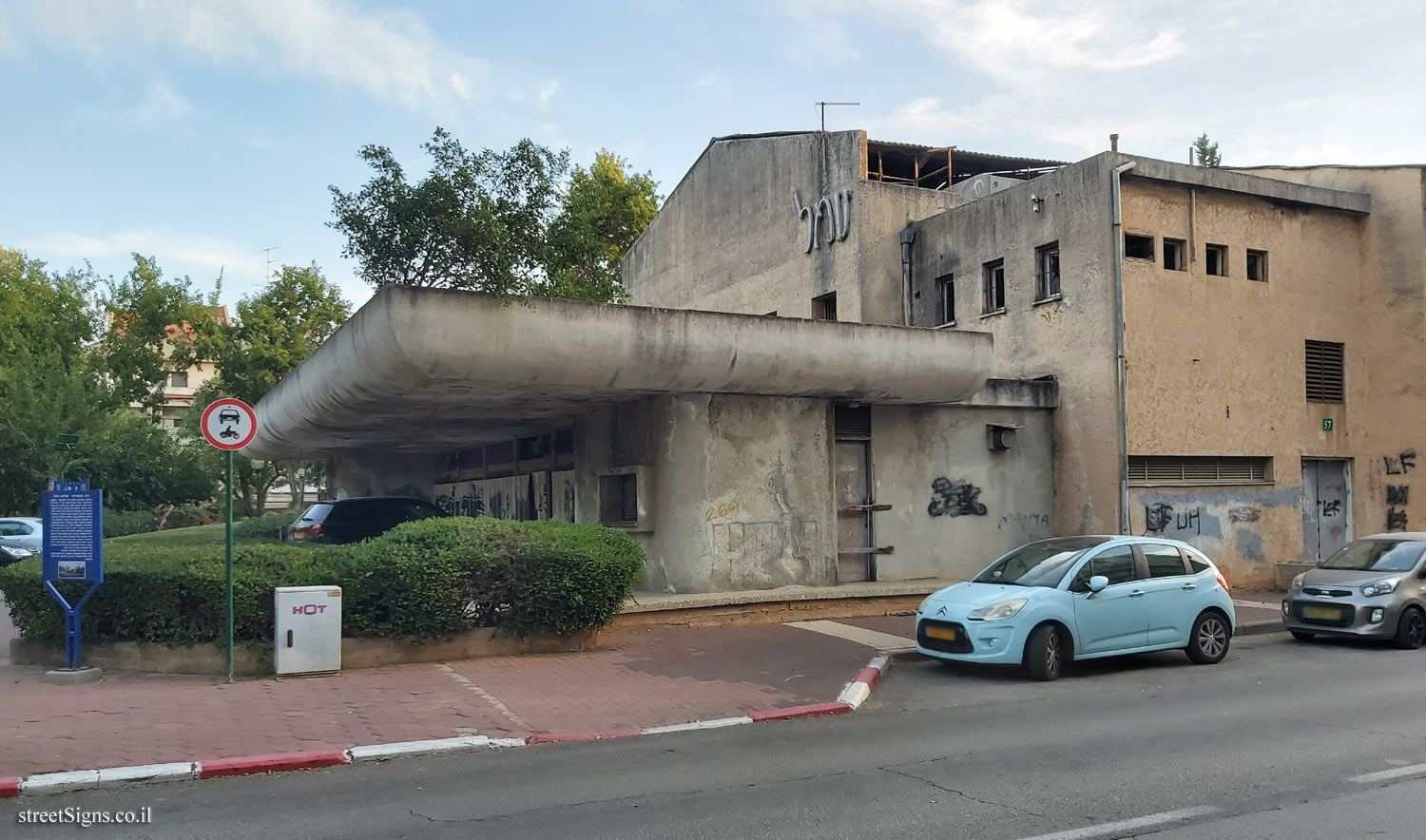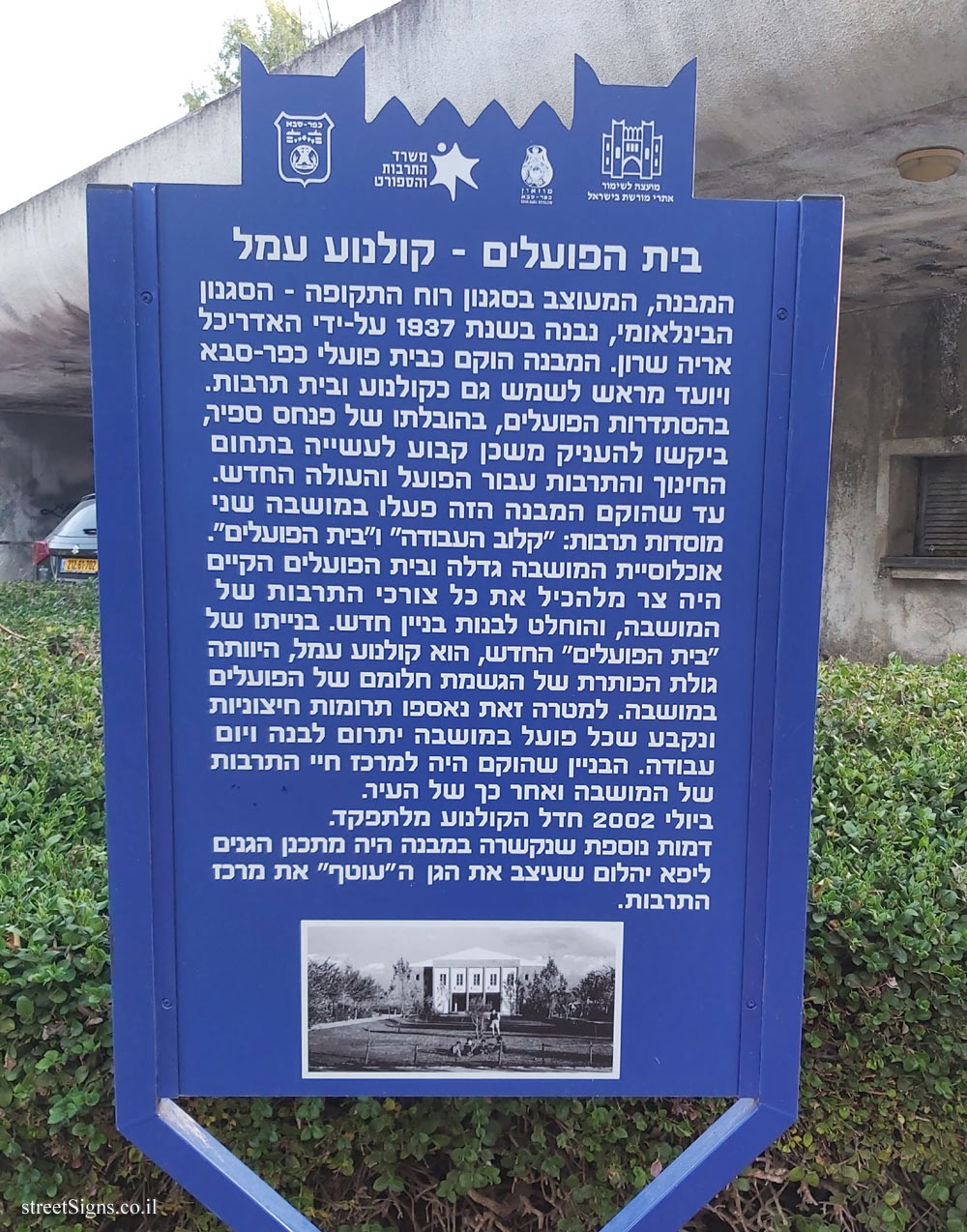On the sign:
תמונה: קולנוע עמל]
[מפת השביל]
[הצד השני של השלט]
בית הפועלים - קולנוע עמל
Workers’ House - Amal Cinema
המבנה, המעוצב בסגנון רוח התקופה - הסגנון הבינלאומי - נבנה בשנת 1937 על-ידי האדריכל אריה שרון, זוכה פרס ישראל ודמות אשר השפיעה רבות על הנוף העירוני בארץ. המבנה הוקם כבית פועלי כפר-סבא ויועד מראש לשמש גם כקולנוע ובית תרבות.
עד שהוקם המבנה הזה פעלו במושבה שני מוסדות תרבות: "קלוב העבודה" ו"בית הפועלים". אוכלוסיית המושבה גדלה ובית הפועלים הקיים היה צר מלהכיל את כל צורכי התרבות שלה, ועל כן הוחלט לבנות בניין חדש. הקמתו של "בית הפועלים" החדש, הוא קולנוע עמל, הייתה גולת הכותרת של הגשמת חלומם של הפועלים במושבה. למטרה זו נאספו תרומות חיצוניות ושליש מהוצאות הבנייה נתקבלו כתרומת ימי עבודה של פועלי המושבה.
הבנייה התארכה מעבר לזמן המצופה בשל המאורעות שפרצו בשנת 1936, ולבסוף חנכו את המבנה אישי ציבור והתושבים בעצרת עם חגיגית ביום 20.8.37 . כשבוע לאחר מועד הפתיחה, הועלתה ההצגה הראשונה "קל להיות יהודי" של תיאטרון ’המטאטא’ ובהמשך ’הבימה’ הציג את "שומרים", ו’האוהל’ הציג את "שאפ". אין בידנו עדות על הסרטים הראשונים שהוקרנו, אך סביר להניח שסרטים כמו ’אידל מיטן פידל’, ’פנג הלבן’ ו’ידו בכל ויד כל בו’, שהוקרנו בתל אביב בשנת 1937, הגיעו אל כפר-סבא זמן קצר לאחר מכן. עם פתיחתו של הקולנוע בן 750 מקומות הישיבה, הפכה המושבה למרכז תרבותי-חברתי שמשך אליו רבים מבין תושבי הסביבה, כגון; גן חיים, רעננה וצופית, וקוימו בו עצרות וכנסים בהשתתפותם של מנהיגי היישוב - דוד בן-גוריון, ברל כצנלסון, יעקב חזן, יוסף שפרינצק ואחרים. האחראים על הבאת הסרטים, ההצגות ופעילויות התרבות בעשורים הראשונים היו שלמה אנגל, אידה פריבר ושמואל זלינגר. בשנת 1954 הוחלט על הרחבת אולם הכניסה לאור הביקוש הרב ולחץ המבקרים. אז גם הוחלט לשנות את שמו של המרכז לשם שגור יותר מ"בית הפועלים" - "עמל", שיש לו מסר סוציאליסטי-פועלי.
במאי 1954 תוכנן להגיע הסרט "אורות הבמה" בכיכובו של צ’רלי צ’פלין. הביקוש היה עצום, ולכן חברו יחדיו שלושת בתי הקולנוע ביישוב - "בית הפועלים" (750 מקומות), "רון" (360 מקומות) ו"הדר" (1600 מקומות), וכך זכו מרבית תושבי המושבה והסביבה לצפות בסרט. סרטים נוספים שהוקרנו מאוחר יותר: "טרזן", "השמן והרזה", "מנון", "מחץ דלתא", "שתי אצבעות מצידון", "אישה יפה".
עם חנוכתו של היכל התרבות בעיר בשנת 1976, רבות מן ההצגות ואירועי התרבות הועתקו אליו ומאוחר יותר, בשנות ה-90 חל מהפך בהרגלי הצפייה והבידור של תושבי העיר וכמות המבקרים במקום פחתה.
ביולי, שנת 2002 חדל הקולנוע מלתפקד.
The building designed in the style and spirit of the times - international style - was built in 1937 by the architect Aryeh Sharon, winner of the Israel Prize and a person who greatly influenced the urban landscape in Israel. The building was erected as a home for Kfar Saba’s workers and its main goal was to function as a movie theater and a cultural center.
Up until the completion of construction of this building, two cultural institutions existed in the colony: The Work Club and The Workers’ House. The population of the colony grew and the existing Worker’s House was too small to house all of the cultural needs. Thus it was decided to build a new building. The establishment of the new workers’ house, the Amal cinema, was the. highlight of the realization of the vworkers’ dream in the colony. For this purpose, external contributions were collected one-third of the expenses came as a contribution of work days of the colony’s workers.
The constructen took longer than was expected because of the riots that broke out in 1936 Finally, officials and the residents dedicated the building at a celebratory ceremony on 20 August 1937. About a week after the. opening, the first performance, "It’s Easy to be a Jew", was staged by the Matateh Theater followed by Habimah production of "Guards" and an Ohel production of "Shap". There is no evidence of the first films that were screened, but it can be assumed that films like "Yidl Mitn Fidel", "The White Fang" and "The Whole World is Against Him", that were screened in Tel Aviv in 1937, reached Kfar Saba not too long after that. With the opening the 750-seat movie house, the colony became a cultural-social center that drew to it residents of the surrounding areas, like: Gan Haim, Ra’anana and Tsofit.
Ceremonies and conferences took place there with the participation of the leaders of the Yishuv - David Ben- Gurion, Berl Katznelson, Ya’acov Hazan, Yosef Sprintzak and others. Ben-Gurion stayed in the home of the Giladi family. Those responsible for bringing films, plays and cultural activities in the first decades were Shlomo Engel, Ida Priver and Shmuel Zelinger. In 1954 it was decided to expand the entrance hall because of the great demand and the pressure of visitors. It was also decided to change the name of the center to an easier name than Workers’ House - Amal (laborer) which has a Socialist-Labor message. With the dedication of the Municipal Cultural Center in 1976, many of the performances and cultural events were moved there and later, in the 1990s, there was a change in the film and entertainment habits of the city residents and the number of visitors to the building decreased. In July 2002 the cinema ceased functioning
סמל העיר כפר סבא
סמל מוזיאון כפר סבא
שביל הראשונים על שם מרדכי שרייבמן
המוזיאון הארכיאולוגי כפר-סבא
ירושלים 35 כפר-סבא
טלפון 09.7640867
THE ARCHAEOLOGICAL MUSEUM OF KFAR-SABA
www.kfar-saba-museum.org

 Click for a larger image
Click for a larger image  Click for a larger image
Click for a larger image  Click for a larger image
Click for a larger image  Click for sign's details
Click for sign's details  Click for sign's details
Click for sign's details